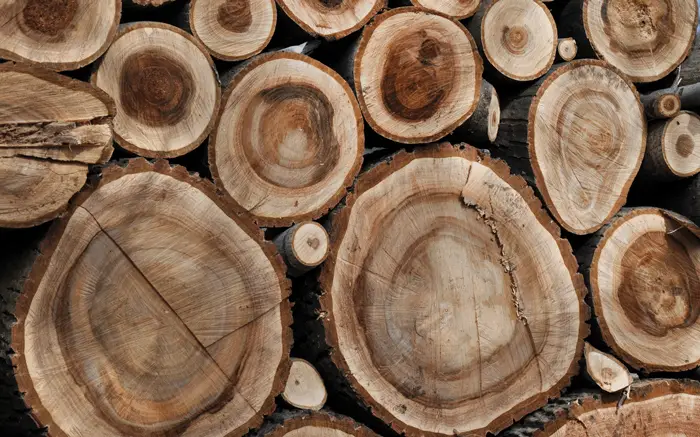Rosewood Vs Walnut – A Detailed Comparison
Rosewood and walnut wood are some of the most commonly used hardwoods in the world. These hardwoods are used for many applications because of their excellent properties, so it’s natural to wonder which is better suited for your project.
So how do you compare rosewood vs walnut? Both rosewood and walnut have beautiful colors and attractive grain patterns. Rosewood has a higher hardness and rosy fragrance, while walnut is easier to work with and doesn’t warp when exposed to moisture.
Read on to learn more about how rosewood compares to walnut in terms of properties, applications, and the pros and cons of each wood.
Rosewood Vs Walnut Comparison Table
The table below shows the differences between rosewood and walnut in short.
| Features | Rosewood | Walnut |
|---|---|---|
| Wood color | Light/golden brown to dark brown, purple or deep red | Ranges from light brown to a dark brown that is closer to chocolate |
| Pattern of grain | Closed grain | Open grain |
| Durability | Great | Good |
| Ease of working with | Challenging to work with | Good |
| Janka scale hardness | 1,780 lbf (pound-force) | 1,010 lbf for black walnut |
| Availability | Rare due to conservation efforts | Readily available |
| Tree height range | 45 – 60 feet | 80 – 150 feet |
| Smell | Rosy fragrance | Faint, earthy scent |
| Density | 820 – 900 kg/m^3 | 570 – 700 kg/m^3 |
| Average price | $25 per board foot | $10 per board foot |
| Common uses | Flooring, cabinets, doors, carving, musical instruments, and veneers | Trims, musical instruments, veneer, furniture, and carving |
Rosewood Vs Walnut: Comparison Of Properties
Rosewood and walnut wood have great qualities that make them great choices for any woodworking project. They have certain characteristics that set them apart. Let’s explore how these two types of wood stack against each other.

1. Color
Rosewood has colors ranging from brown to purplish brown. For instance, East Indian rosewood is known to have colors varying between golden brown and dark reddish-brown.
Walnut wood has rich brown colors, which can vary between light brown and dark chocolate, with some dark streaks running through it. Sometimes, walnut wood has a purple or green hue as well.
2. Grain
Rosewood tends to have irregular, wavy grain lines, which are sometimes interlocked. These lines often form swirling patterns punctuated by streaks and stripes, giving rosewood an appealing aesthetic.
Unlike walnut wood, rosewood is a closed-grain wood with tiny, tight pores that produce fine texture and a smooth appearance.
And Walnut wood typically has straight grain lines that are sometimes slightly curved, looking like the arches you would find on a cathedral window.
Because of its open pores, walnut wood has an open grain pattern that gives it a coarse texture. Hence, you must fill these pores during finishing to achieve a smooth surface.
3. Hardness
Rosewood is widely considered one of the hardest woods available. This wood is highly rated on the Janka hardness test, with a score averaging about 1,780 pounds of force.
Walnut wood is also classified as hardwood but is a few classes below rosewood in hardness. This wood has a Janka hardness rating of about 1,010 pounds of force.
4. Rot resistance
In terms of rot resistance, rosewood is exceptional. It contains natural oils and other substances that act as natural barriers to water and repel fungal attacks. Rosewood’s density ranges between 820 – 900 kg/m^3. This high density further increases the wood’s impressive rot resistance.
Walnut wood density ranges between 570 – 700 kg/m^3. Hence, though walnut’s rot resistance is good, it doesn’t quite reach rosewood’s level because it lacks natural oils.
5. Workability

Working with rosewood is challenging because of two main reasons:
- Hardness – rosewood’s hardness makes it hard to shape and carve without using specialized tools to prevent splintering.
- Rosewood sometimes has some chalk deposits that blunt cutting tools quickly.
On the other hand, walnut wood is much easier to work with, though it may still be challenging. Its straight grain lines and lower hardness make it much easier than rosewood to carve and shape.
6. Durability
Rosewood’s hardness prevents surface scratches and dents, making the wood highly durable. Rosewood is also highly rot-resistant and very resistant to termites.
Though walnut wood resists scratches, dents, and rotting, it does so to a lower degree than rosewood. However, unlike rosewood, walnut is highly resistant to warping and shrinking due to moisture or temperature fluctuations.
Rosewood Vs Walnut: Common Uses
Both rosewood and walnut wood possess properties that suit them to a wide range of applications. Here are some common applications for each type of wood;
a) Rosewood
The most common uses of rosewood include;
- Musical instruments
The aesthetic appeal, durability, and tonal qualities of rosewood make it a good choice for acoustic guitars, ukuleles, bass guitars, oboes, and mandolins.
- Furniture
Due to its beautiful grain pattern, rich color, and durability, rosewood is a popular choice for high-quality furniture like cabinets, executive desks, and decorative veneers.

- Flooring
Rosewood is great for flooring due to its durability, rot resistance, and luxurious appearance. Its color also tends to saturate more with time, rendering it more beautiful.
- Craftsmanship
Though rosewood can be challenging to carve, it is widely used to make unique, aesthetically pleasing, artistic crafts like sculptures.
b) Walnut
The most common uses of walnut wood include the following;
- Furniture
The distinctive grain pattern and rich colors make walnut wood a great choice for dining tables, chairs, cabinets, high-end executive desks, and chairs.

- Carving
Since walnut wood is easy to work with, is durable, and has an attractive appearance, it’s used to make carvings like gunstocks, sculptures, and knife handles.
- Musical instruments
Several musical instruments, such as bass guitars, acoustic guitars, ukuleles, and even drums, are made with walnut wood.
- Flooring
Walnut wood is extensively used for flooring because it’s beautiful and doesn’t warp easily, even when exposed to moisture.
- Paneling and trims
Panels and trims made of walnut wood are commonly used to add a touch of elegance and luxury to ceilings, walls, and moldings.
Rosewood Vs Walnut: Pros And Cons
Both rosewood and walnut wood have their pros and cons as shown below.
Rosewood

Pros
- Highly durable
- Aesthetically appealing
- Great tonal qualities when making musical instruments
- Has a good fragrance
- Highly rot-resistant
Cons
- There are conservation concerns
- Rosewood musical instruments are heavy due to the wood’s high density
- Rosewood can be hard to work with
Walnut wood

Pros
- Easy to work with
- Durable
- More readily available than rosewood
- Aesthetically pleasing
- Produces balanced tones in musical instruments
Cons
- Can bleach due to too much exposure to sunlight
- Heavy
FAQs
Here are some answers to common questions about rosewood and walnut wood.
Q: Which wood is better, rosewood and walnut?
Both rosewood and walnut are great for most uses. Hence, choosing which wood is better depends on personal preference and the specific application you have in mind. For instance, walnut would be great for an intermediate-skilled craftsman, while an expert may use rosewood.
Q: Rosewood vs walnut, which is better for guitars?
Rosewood and walnut wood have different tonal qualities, so choosing the better wood for your guitar depends on personal preference and the desired tone. Walnut produces more balanced tones, while rosewood produces a full, warm tone and remarkably sustains resonance.
Q: Rosewood vs walnut, which is more sustainable?
Walnut wood is generally more readily available than rosewood, though certain species, such as black walnut, can be hard to come by.
On the other hand, rosewood is an endangered tree species protected by the United Nations, so widespread use of its wood is not sustainable.
Conclusion
In summary, the choice between rosewood and walnut comes down to personal preference and intended application. Rosewood has great tonal qualities, is highly durable, and has a beautiful appearance. However, rosewood is tough to carve and is an endangered tree species.
On the other hand, walnut offers balanced tonal qualities, has a good aesthetic, is durable, and resists warping when exposed to moisture. Though walnut wood is great for many applications and readily available, it bleaches when exposed to too much sunlight.




